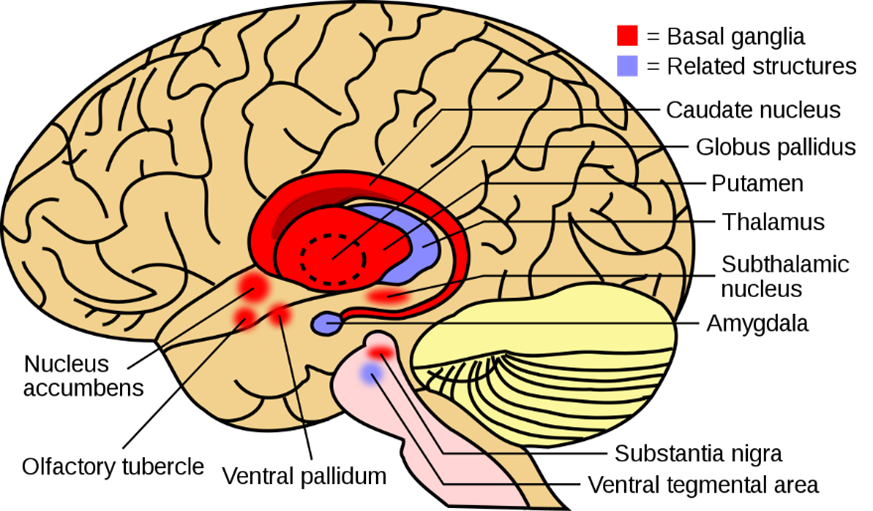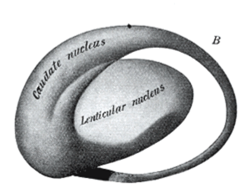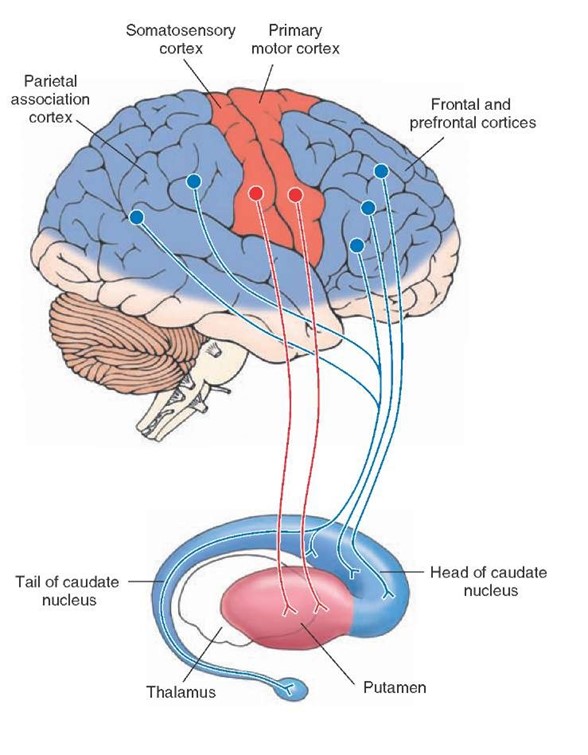The Basal Ganglia
AbdulSamad Olagunju / December 25, 2021
5 min read
Welcome to another blog post!
Quote of the Post:
"Cadaver dissection is a medical rite of passage and a trespass on the sacrosanct, engendering a legion of feelings: from revulsion, exhilaration, nausea, frustration, and awe to, as time passes, the mere tedium of academic exercise." - Paul Kalinithi
Before you can make a movement, a part of your brain needs to give the go-ahead signal. This is the responsibility of the Basal Ganglia. The Basal Ganglia is your caudate nucleus, putamen, substantia nigra reticularis and compacta, globus pallidus, and subthalamic nucleus.
The Basal Ganglia allows motor movements to be initiated by the primary motor cortex. The Basal Ganglia are subcortical nuclei, and they receive input from the cortex and send outputs to the premotor, supplementary, and primary motor cortices.
Let’s try to unpack that. Subcortical means below the cortex (surface) of the brain. So we know the basal ganglia are under the surface of the brain. What about ganglia? Ganglia are collections of neuronal cell bodies in the peripheral nervous system.
Now, I know what you’re thinking. Aren’t the brain and spinal cord a part of the central nervous system? And aren’t nuclei the cell bodies found in the central nervous system? So—why do we call it the basal ganglia, and and not the basal nuclei?
Yeah, scientists can make things so confusing sometimes. The name is downright misleading.
Alright, let’s get back to the neuroscience. It should now make sense to you that the basal ganglia are the neurons in your brain located in the caudate nucleus, putamen, substantia nigra reticularis and compacta, globus pallidus, and subthalamic nucleus.
The Basal Ganglia influence your voluntary motor movements. Here’s a picture:

Some important terminology used when people discuss the basal ganglia:
- The Lentiform Nucleus include the globus pallidus and putamen.
- The striatum includes the caudate nucleus and putamen.
Take a look at the lentiform nucleus and caudate nucleus:

To understand the Basal Ganglia, let us try to imagine a person trying to start a motor movement. Their cerebral cortex (specifically the supplementary and premotor area) plans out a movement and sends a signal to their caudate nucleus and putamen (striatum) on the same side of their brain. This signal will be an excitatory glutamatergic projection.

So, the striatum will receive an excitatory input from the cortex if we would like to start a movement. What happens next?
Dopamine is released from substantia nigra compacta neurons.
This dopamine binds to D1 and D2 receptors of the neurons in the striatum. Direct pathway neurons in the striatum have D1 dopamine receptors. Indirect pathway neurons in the striatum have D2 receptors.
Let’s discuss direct pathway neurons in the striatum first.
When dopamine binds to the D1 receptors of striatal neurons, striatal neurons are depolarized. This results in the activation of the direct pathway.
These neurons in the striatum may receive an excitatory signal, but they release an inhibitory signal. They are GABAergic neurons (their neurons release GABA), and GABA is an inhibitory transmitter.
These direct pathway neurons in the striatum inhibit the globus pallidus internus by sending it GABAergic projections.
The globus pallidus internus itself sends inhibitory projections to the thalamus. So, if the globus pallidus internus is inhibited, it cannot inhibit the thalamus.
Therefore, as the thalamus is not inhibited by the globus pallidus internus, it can send excitatory projections with glutamate to the cerebral cortex. You can now make a movement. This is the direct pathway.
Let us now discuss the indirect pathway.
The indirect pathway involves D2 receptors. When dopamine binds to D2 receptors, indirect pathway striatal neurons are hyperpolarized. This means that they are inhibited due to the action of dopamine.
Therefore, they cannot release GABA to inhibit the globus pallidus externus. The globus pallidus externus is responsible for inhibiting the subthalamic nucleus. If the subthalamic nucleus is inhibited, it cannot send excitatory glutamatergic projections to the globus pallidus internus. The globus pallidus internus is not activated to release GABA to inhibit the thalamus. The thalamus can send excitatory projections to the primary motor cortex, stimulating it so you can make motor movements.
If your basal ganglia is trying to inhibit a movement, what do you think will happen? Take a look at this diagram to try to figure out what happens. Hint: Start at the cerebral cortex.

From 2-minute Neuroscience, check them out on YouTube: https://www.youtube.com/channel/UCUgZq9PkDp1xaEivtcfJPSg
You figured it out? Alright, let’s go over your answer to see if you’re correct.
The cerebral cortex will send excitatory projections to the indirect striatal neurons. The substantia nigra pars compacta will not release dopamine. Therefore, your D1 and D2 receptors will receive no dopamine. As your D1 receptors get no dopamine, you direct pathway neurons will not be activated. As a result, your globus pallidus internus will not be inhibited.
In addition, your indirect striatal neurons will not be hyperpolarized as there is no dopamine binding to your D2 receptors. They are free to inhibit your globus pallidus externus. Your globus pallidus externus cannot inhibit your subthalamic nucleus. Your subthalamic nucleus can send excitatory glutamatergic signals to your globus pallidus internus, and it will send an even stronger inhibitory signal to your thalamus. Your thalamus cannot send excitatory signals to your cerebral cortex, and your movement is inhibited.
Take a look through this website to learn more about neuroscience and the basal ganglia: http://what-when-how.com/category/neuroscience/
Sources: